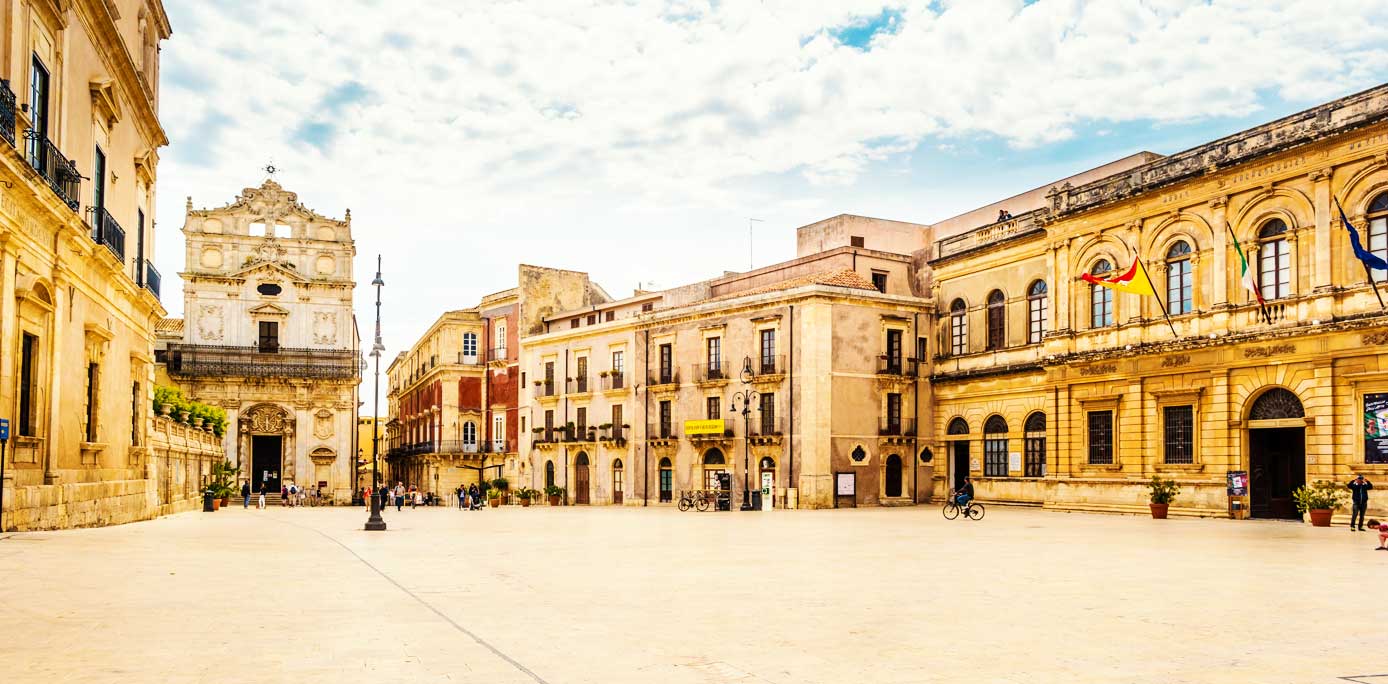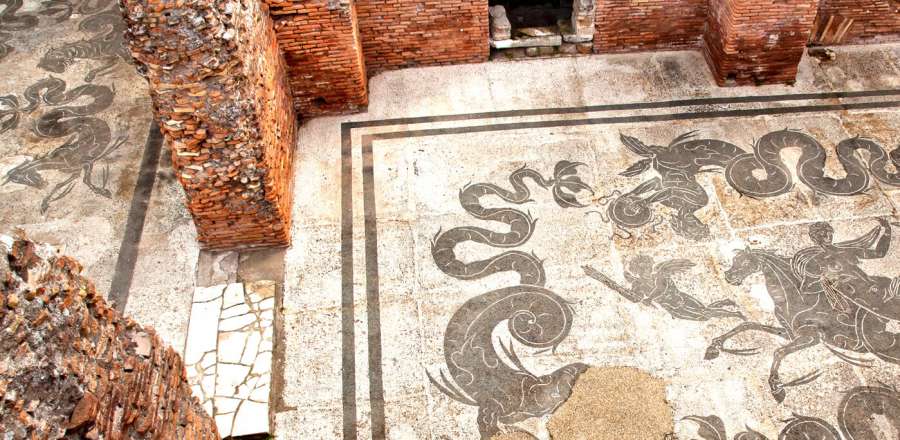Nestled on a little island, off the southeastern tip of Sicily stands a gleaming white cathedral. As the hot Mediterranean sun hits its towering Corinthian columns and saintly statues, the Baroque façade lights up. It’s an architectural gem and beautiful sight for the faithful and visitors alike. But there’s more to this church than meets the eye so let’s peel back the layers to uncover a story of 4 faiths, 6 conquerors and 2500 years of history.
The home of this layer-cake cathedral is the little island of Ortigia, dangling directly off the seafront of Siracusa. Known locally as the Città Vecchia, or Old City, Ortigia was the easily defensible medieval seat and original birthplace, 2700 years ago, of the metropolis that grew quickly under the ancient Greeks to become the most important city of Magna Graecia, or Greater Greece. In fact, even given the modern urban sprawl of Syracuse, the ancient city was around three times the size of today’s hub, even equaling Athens, with philosopher Cicero describing it as “the greatest Greek city and most beautiful of them all”.
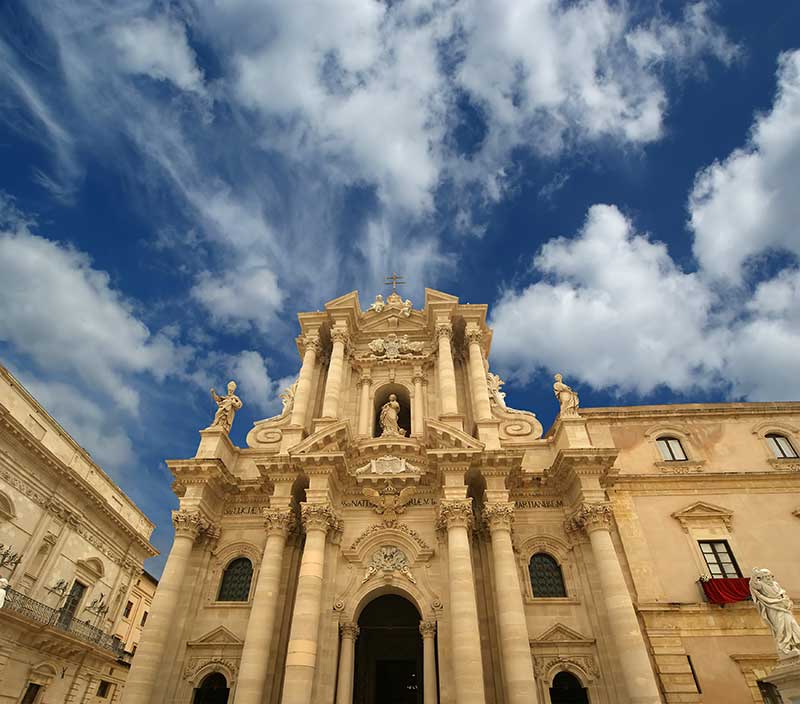
The Duomo of Syracuse is magnificent, just as its history © Vladimir Zhuravlev | Dreamstime.com
At the time Syracuse and Sicily were valued prizes. Whoever controlled the island controlled the shipping lanes around it linking the eastern and western Mediterranean. It’s no surprise, then, that Sicily was fought over many times down the ages.
In 480 BC, the North African Carthaginians approached, keen to secure a foothold. They valiantly attacked the Syracusian tyrant Gelon and his troops at Imera but sadly they were no match. And Gelon rammed his victory home, using loot from the vanquished Carthaginians to build a striking temple to honor Athena, goddess of war, at the heart of his stronghold.
The temple was an architectural marvel in its day.
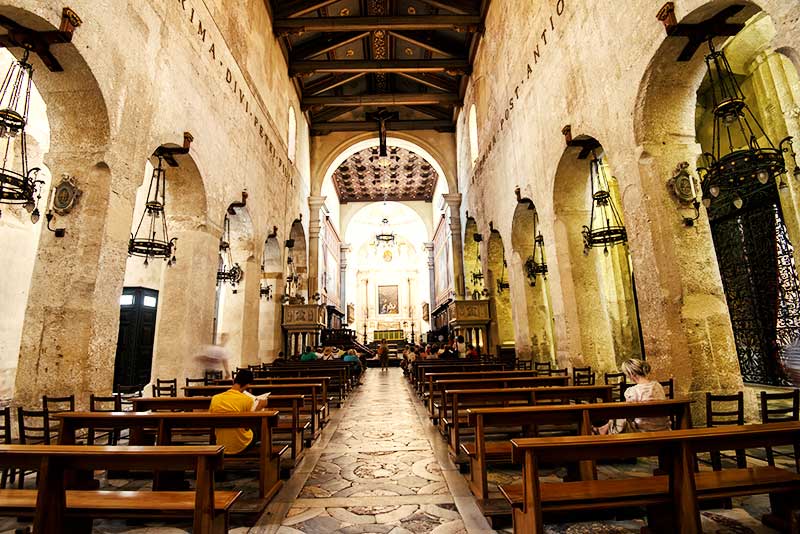
The home of this layer-cake cathedral is the little island of Ortigia, dangling directly off the seafront of Siracusa
Built on the grounds of two previous Hellenic temples dating back to 1100 BC, Gelon’s new edifice had an internal cella, or sacred chamber, encircled by a glorious colonnade of 40 golden limestone, Doric columns; 14 on the long sides and 6 on the short ones. The fluted columns soared high into the azure Mediterranean sky, dominating the Ortigia acropolis at the highest point of the little island. And topping the temple was a triumphant statue of Athena clutching a golden shield that, together with the gold and ivory bas-relief ornamentation around the temple, could be seen glinting in the sunlight for miles around. And all this before a single block of the Parthenon, also dedicated to Athena, had ever been laid in Athens. Even ancient intellectuals Plato, Cicero and Athenaeus mentioned the beauty of the temple built a full 2500 years before the Duomo we see today.
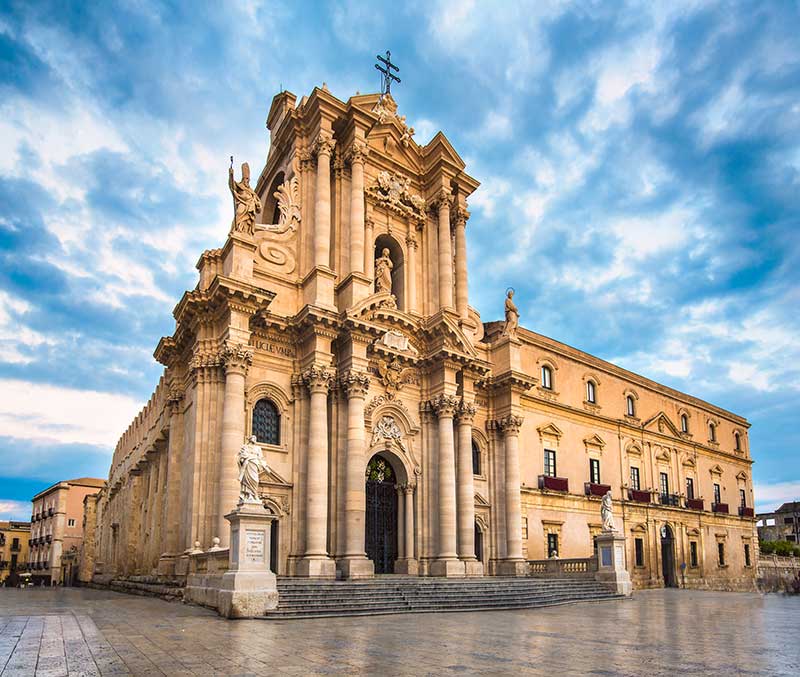
In 1693 an enormous earthquake struck Sicily destroying large parts of the Duomo including its ornate Norman façade and bell tower
Gelon’s temple was a triumph, reflecting Syracuse’s importance and sending a message both to invaders and its cultural rival Athens that the city was strong, strategically important and just as rich as the Greek capital.
After the Greeks came the Romans. Syracuse became capital of Roman Sicily and remained an important port for trade. The invaders don’t appear to have left their physical mark on the temple but they did have an impact nonetheless introducing the Edict of Milan in 313 AD granting Romans freedom of religion. Sicily had already been introduced to Christianity by St Paul on his way to Rome in 57 AD and St Marziano, the first bishop, was continuing the preaching in the third century so the new edict enabled open worship.
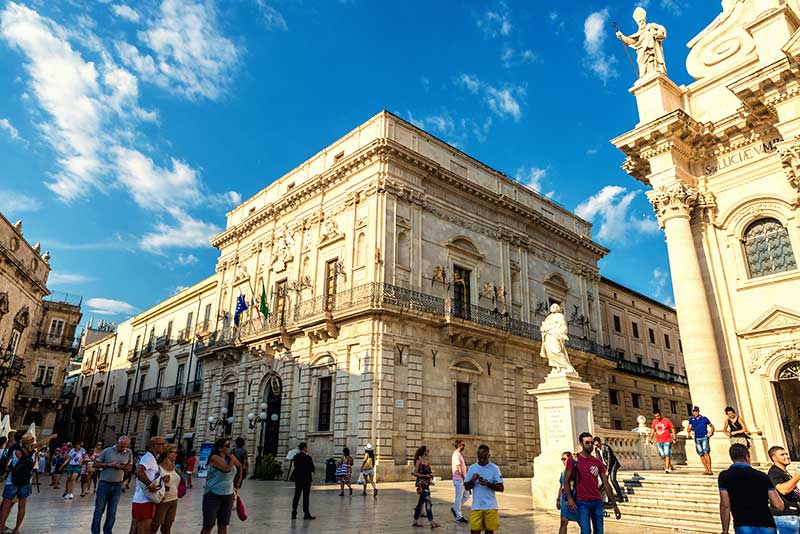
Piazza Duomo and the cathedral with people around in the old town of the historic village of Siracusa in Sicily © 22tomtom | Dreamstime.com
Next came the Barbarians and then the 6th century Byzantine phase when the first major alterations were made to the temple. First the gaps between the battered outer colonnade columns were filled in to enlarge the internal space whilst leaving the decorative columns visible, embedded into the new walls. And then eight arches were knocked through the walls of the inner cella to open up the chamber and create a Christian church. Bishop Zosimo later made the new church his cathedral in the 7th century, but this was far from the end of the story.
Within a couple of hundred years Arabs had invaded Sicily. The citizens of Syracuse took refuge in their Duomo, but were tragically massacred there before the conquerors turned the church into an Islamic mosque in 878 AD. And so it stayed for around 220 years before the Normans arrived, retaking the city and installing Roger I of Sicily in 1105.
Once again, the incomers changed the structure. And how.
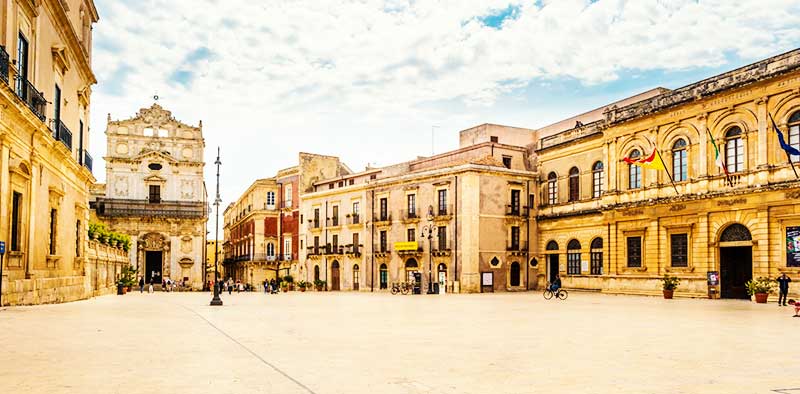
Built on the grounds of two previous Hellenic temples dating back to 1100 BC, Gelon’s new edifice had an internal cella, or sacred chamber, encircled by a glorious colonnade of 40 golden limestone, Doric columns
Externally, the most obvious change was to add a brand new façade although fortunately the original Greek Doric columns to the sides were left in situ. Internally, the Normans undertook more extensive works building up the walls of the nave and raising the roof high to accommodate new second floor windows to flood the interior with sunlight. And finally, they added multi-colored, ornamental marble mosaics in the church apses, some of which are still visible today.
But even then the story was still not complete.
In 1693 an enormous earthquake struck Sicily destroying large parts of the Duomo including its ornate Norman façade and bell tower. The tower would never be rebuilt but the Sicilian architect Andrea Palma took the commission to re-design the façade in the high Sicilian Baroque style overseeing its construction between 1725 and 1753. Palma went to town on his decorative design, incorporating ten soaring Corinthian columns topped with stylized Acanthus leaves. Sculptor Ignazio Marabitti then added the impressive statues. Internally, too, the Duomo was restored with the addition of an altar canopy designed by architect Luigi Vanvitelli, an historic marble font and an antique statue of the Madonna in the Snow by Antonello Gagini: perfect embellishments for an ancient church.
The impact was magnificent and today, after the addition of the ancient heraldic shield of Syracuse during a period of economic prosperity in the 1800s, the Duomo wears its history for all to see. From the ancient Greek Doric columns of the original Pagan temple that still support the very fabric of the building after 2500 long years, to the bold mosaic marble floors of the Normans. Or from the climbing Norman ceiling to the highly ornamental Baroque façade, every successive newcomer has added their own flavor to this wonderful church. All perhaps, apart from the Arab invaders of whom sadly little obvious trace remains in the building. To walk through its doors is to take a trip back in time to 500 years before Christ was even born. And the result for the visitor is a wonderful, kaleidoscopic journey through history via 6 conquerors and an earthquake, 4 faiths including, two pagan creeds, and over two and half thousand years. If you’ve ever wanted to know more about Sicily’s heritage, the Duomo of Syracuse demonstrates it all under a single roof and its one not to miss.
